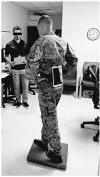The Relationship Between Human-rated Errors and Tablet-based Postural Sway During the Balance Error Scoring System in Military Cadets
- PMID: 35658667
- PMCID: PMC10170225
- DOI: 10.1177/19417381221093566
The Relationship Between Human-rated Errors and Tablet-based Postural Sway During the Balance Error Scoring System in Military Cadets
Abstract
Background: The Balance Error Scoring System (BESS) is commonly accepted as a valid measure of postural stability. However, reliability values have varied, and subtle changes undetectable with the human eye may exist postinjury. The inertial measurement unit in commercially available tablets has been used to quantify postural sway (instrumented Balance Error Scoring System [iBESS] volume). However, iBESS has not been validated in a military population, and the stability of the tests beyond 1 week is unknown.
Hypothesis: iBESS volume is capable of objectively measuring postural sway during the traditional BESS.
Study design: Prospective repeated-measures study.
Level of evidence: Level 3.
Methods: Eighty-three cadets (40.96% women; age 20.0 ± 1.44 years; height 68.7 ± 4.1 inches; weight 166.7 ± 30.2 lb) with no history of concussion or lower extremity injury agreed to participate. All participants completed the BESS at baseline and 6 months post baseline. During testing, a tablet equipped with an inertial measurement unit was positioned on the participant's sacrum to capture postural sway.
Results: Moderate to strong correlations were exhibited between baseline measurements for single-limb (SL)-firm (r = 0.84; P < 0.01), tandem (TAN)-firm (r = 0.85; P < 0.01), double-limb (DL)-foam (r = 0.50; P < 0.01), SL-foam (r = 0.59; P < 0.01), and TAN-foam (r = 0.79; P < 0.01). Balance improved significantly at 6 months for SL-firm human-rated errors (Effect Size [ES] = 0.32) and for SL-firm (ES = 0.38), DL-foam (ES = 0.21), and SL-foam iBESS volume (ES = 0.35). Moderate to strong correlations were exhibited between human-rated and iBESS change scores for SL-firm (r = 0.71; P < 0.01), TAN-firm (r = 0.75; P < 0.01), and TAN-foam (r = 0.71; P < 0.01), and a weak correlation was exhibited for DL-foam (r = 0.29; P < 0.01) and SL-foam (r = 0.40; P < 0.01).
Conclusion: Moderate to strong correlations existed between human-rated BESS errors and iBESS volume at baseline and between change scores. In addition, iBESS volume may be more sensitive to balance changes than the human-rated BESS.
Clinical relevance: This evidence supports the use of iBESS volume as a valid measure of postural stability in military cadets. iBESS volume may provide clinicians with an objective and more sensitive measure of postural stability than the traditional human-rated BESS.
Keywords: iBESS; postural stability; validity.
Conflict of interest statement
The authors report no potential conflicts of interest in the development and publication of this article.
Figures
Similar articles
-
Quantification of the Balance Error Scoring System with Mobile Technology.Med Sci Sports Exerc. 2015 Oct;47(10):2233-40. doi: 10.1249/MSS.0000000000000656. Med Sci Sports Exerc. 2015. PMID: 26378948 Free PMC article.
-
Sway Area and Velocity Correlated With MobileMat Balance Error Scoring System (BESS) Scores.J Appl Biomech. 2016 Aug;32(4):329-34. doi: 10.1123/jab.2015-0273. Epub 2016 Mar 8. J Appl Biomech. 2016. PMID: 26957482
-
Level of Agreement Between Human-Rated and Instrumented Balance Error Scoring System Scores.Ann Biomed Eng. 2019 Oct;47(10):2128-2135. doi: 10.1007/s10439-019-02274-5. Epub 2019 Apr 22. Ann Biomed Eng. 2019. PMID: 31011917
-
Reliability and validity evidence of multiple balance assessments in athletes with a concussion.J Athl Train. 2014 Jul-Aug;49(4):540-9. doi: 10.4085/1062-6050-49.3.32. Epub 2014 Jun 16. J Athl Train. 2014. PMID: 24933431 Free PMC article. Review.
-
Postural control deficits identify lingering post-concussion neurological deficits.J Sport Health Sci. 2016 Mar;5(1):61-69. doi: 10.1016/j.jshs.2016.01.007. Epub 2016 Jan 11. J Sport Health Sci. 2016. PMID: 30356901 Free PMC article. Review.
Cited by
-
Leg Dominance Effects During Single- and Dual-Task Modified Balance Error Scoring System Assessment in Collegiate and High School Athletes.Orthop J Sports Med. 2025 Jan 1;13(1):23259671241301771. doi: 10.1177/23259671241301771. eCollection 2025 Jan. Orthop J Sports Med. 2025. PMID: 39758141 Free PMC article.
References
MeSH terms
LinkOut - more resources
Full Text Sources
Medical
Research Materials


